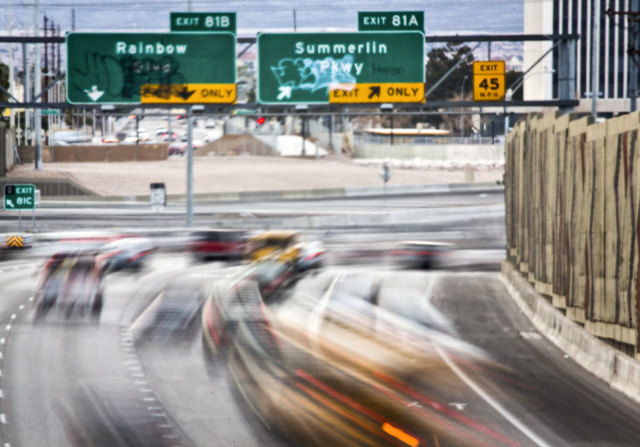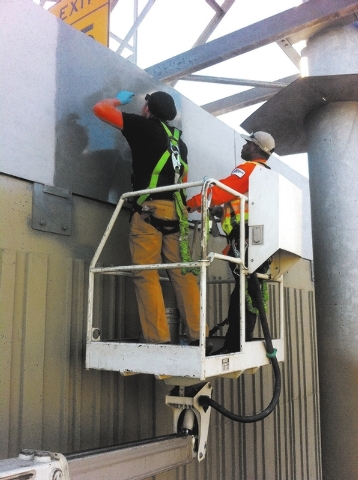Cleaning up graffiti a costly battle in the Las Vegas Valley



Someone’s initials etched in white marker on a utility pole.
A large splotch of black paint unleashed on a freeway sound wall, straight from a fire extinguisher, one of the latest techniques.
A toilet seat scratched up with a tiny key.
The inside of an elevator slapped with one of those stickers that are hard to peel off and say “Hello: My name is …”
Only there’s no name, just the initials of some tagging crew, with a “k” at the end to signify “crew.”
These are minor annoyances to some in the Las Vegas Valley, but major expenses for the cleanup — $30 million every year in Clark County and its major cities.
“We remove it, then they’re back at it, putting their initials somewhere for who knows what reason,” says John Riggs, the supervisor in charge of the graffiti removal team at the Nevada Department of Transportation District 1.
The motivation, Metropolitan Police Department detectives say, is “fame and notoriety,” and rarely does it have to do with any sort of gang affiliation.
The most recent high-profile abomination was a pair of blotted-out signs on northbound U.S. Highway 95 this past month. The vandalism, carried out at 40 feet up in the air, left the Summerlin Parkway and Rainbow Boulevard exit signs illegible, leaving out-of-towners guessing which exit was theirs as others wondered — “How in the heck do they get up there?”
“They just shimmy up the pole, then crawl up over the top of the sound wall,” said Aaron Linebarger, who had the inglorious job of washing it all off in the early morning hours of Jan. 26 for NDOT in Las Vegas, where he’s chief of the graffiti removal crew.
It took Linebarger and co-worker David Tagupa, capable laborers in their 30s, a good hour to wipe both signs clean, using a special foam and steel wool.
And what an undertaking it was. A few lanes had to be shut down at midnight. The men, in harnesses, had to be hoisted up by bucket truck. Then a cushion truck, with one of those large bright arrows, backed them up at the work site as a dozen other NDOT workers provided traffic control.
All told, the cleanup cost $2,000 in labor and equipment, Linebarger estimated.
Asked how he felt, standing way up high, cleaning up as cars whizzed by below, he said, “It’s my job. It’s not my first rodeo, and I don’t think it will be my last, either.”
He’s been playing a cat-and-mouse game with dozens of tagging crews about four years, dipping into the $80,000 that the state sets aside for graffiti removal. And that’s just a drop in the bucket compared with the county and the cities of Las Vegas, Henderson and North Las Vegas, which have substantially larger removal programs.
When the NDOT crew isn’t cleaning up the signs, it’s taking them down, at a cost of “thousands of dollars” apiece, said Mohamed Rouas, assistant district engineer for NDOT’s District 1.
With each marking up, Rouas said, the signs lose more of their reflective surface. If you look at them closely, you’ll see the worn patches. Over time, they are replaced, and the taggers ultimately win the battle, but then again they also get arrested from time to time, he added.
And they don’t necessarily have to get caught in the act, he said.
“Often their graffiti is their signature. It’s their calling card,” Rouas said.
And punishment is doled out. A few years ago, an 18-year-old from Sparks was sentenced to a year in prison for marking up a highway sign in a tunnel at McCarran International Airport, and he was a first-time offender, noted Detective Scott Black, who’s in charge of grafitti enforcement for Metro.
In autumn 2010, a juvenile served a six-month stint in juvenile detention after he marked up the precious red rocks with black spray-paint at the Red Rock National Conservation Area.
In 2013 alone, 650 people were arrested for tagging, said Black, who has a team that closely documents crime scenes. Some perpetrators do jail time, some pay fines, some get probation. Most end up performing 100 hours of community service, wiping clean the very walls that they and their cohorts have vandalized.
And they aren’t all kids with too much time on their hands after school, if they’re even going to school, he said. Half of the violators are adults, some in their 40s and 50s, and there have even been a few violators who have held full-time jobs as managers at casinos, he said.
“This is vandalism, this is not art, as they would have you believe,” Black said. “And their primary motive is to achieve fame and notoriety. They want their initials up there more than anybody else’s. It’s one big game to see who can become the most noticed.”
So vast is the tagging universe that Black helped make arrests a couple of years ago for the Los Angeles County Sheriff’s Department when a dozen taggers migrated to Las Vegas to pick up where they left off in California, spray-paint bottles in hand.
He’s been on Metro’s graffiti beat for 14 years. He’s so versed in the “motivation” of the tagger that he has helped legislators in Carson City write tougher laws. The most recent one, which took effect in late 2013, made it an automatic felony if a tagger defaces murals in the downtown arts district or leaves a calling card on historic landmarks — the sign, “Welcome to Fabulous Las Vegas,” is just one example.
“They’d better think twice before they start defacing historical structures,” he warns of Senate Bill 237.
“We might not be winning the war, but I like to think that we’ve drastically reduced it. Graffiti is usually the public’s No. 1 complaint aside from maybe traffic problems,” Black said.
He knows because he’s often on the other end of the line when somebody calls in to complain. His office, graffiti enforcement, falls under the auspices of the gang unit.
However, the assumption that all taggers are affiliated with some gang couldn’t be further from the truth, he said. Most of them are just obsessed with defacing public property and getting their names and initials out there for the public to see.
“And the quicker you get on it and remove it, the quicker you make the neighborhoods safer,” he said. “Graffiti can be a draw for criminals, just like boarded-up houses and broken windows.”
Contact reporter Tom Ragan at tragan@reviewjournal.com or 702-224-5512.


















